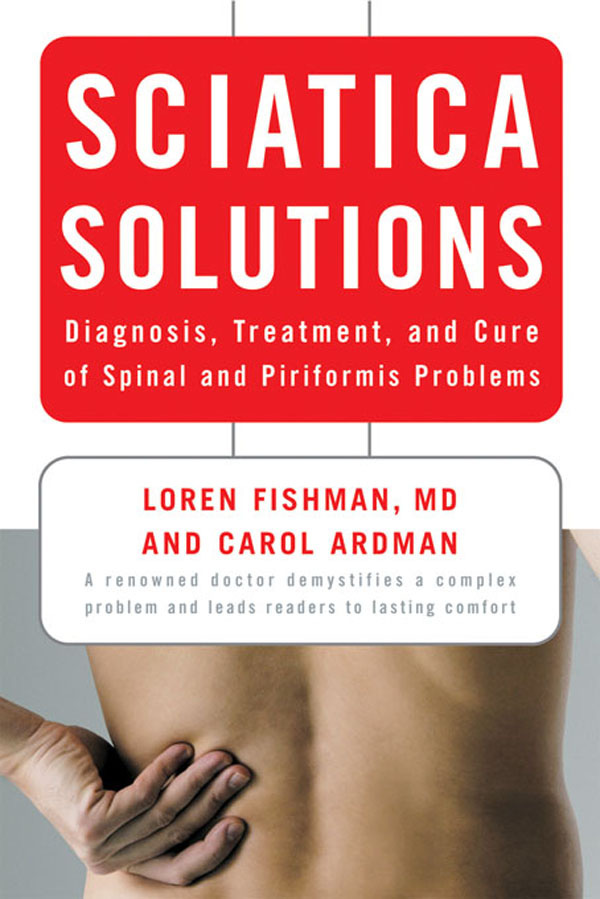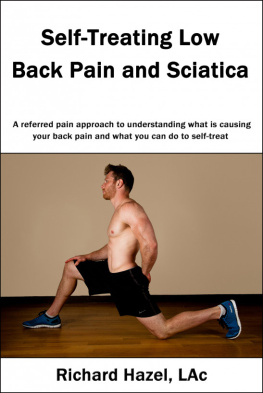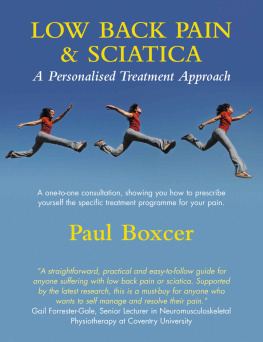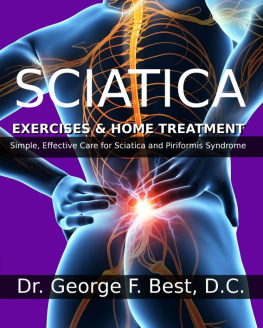
Also by Loren Fishman, MD, and Carol Ardman
B ACK P AIN : H OW TO D IAGNOSE AND C URE
L OW B ACK P AIN AND S CIATICA
C URE B ACK P AIN WITH Y OGA
SCIATICA SOLUTIONS
Diagnosis, Treatment, and Cure for
Spinal and Piriformis Problems
Loren Fishman, MD,
and Carol Ardman

W. W. NORTON & COMPANY
NEW YORK LONDON
This book is dedicated to Edward F. Delagi, MD, esteemed teacher, fellow fisherman, and friend, who approached electrodiagnosis as an extension of the physical examination, making possible a logical approach to sciatica.
ACKNOWLEDGMENTS
W E WOULD LIKE TO THANK Tova Ovadia, PT, for her experience and advice through the years, and for her caring for all patients, especially those with sciatica and piriformis syndrome. To Stephanie Leaf, PT, our gratitude for editorial suggestions and oversight.
For invaluable assistance with the surgery section of this book, we are indebted to Franco Cerebona, Chief of Spinal Surgery, Department of Orthopaedic Surgery, at St. Vincents Hospital in New York City.
It was our luck to find Robert Finkbeiner, who has done intelligent, accurate drawings for this book, and has offered creative solutions to technical problems.
We are grateful to Evan Carver for his responsiveness and dependable good humor. Thank you to our patient editor, Jill Bialosky, and to Ellen Levine, our friend and agent.
NOTE TO READERS
T HIS BOOK is not a substitute for medical advice and assistance. The judgment of individual therapists and physicians who know you is essential. Although the information in this book may help you identify the cause of your sciatica, only a doctor or other professional can provide a definitive diagnosis.
CONTENTS
SCIATICA and PIRIFORMIS SYNDROME
DEFINING THE PROBLEM
CAUSES AND TYPES OF SCIATIC-TYPE PAIN
THE NERVOUS SYSTEM AND SELF-DIAGNOSIS
DIAGNOSTIC TESTS AND NERVE FUNCTION
CONDITIONS THAT CAUSE SCIATICA
CONTROL and CURE
OUTSMART SCIATICA WITH TRICKS YOU CAN DO ON YOUR OWN
PHYSICAL THERAPY
MEDICATIONS
INJECTIONS
SURGERY
NONMEDICAL TREATMENT AND PREVENTION
NUTRITION AND LIFESTYLE
ALTERNATIVE MEDICAL APPROACHES
Part I
SCIATICA and PIRIFORMIS SYNDROME
Chapter I
DEFINING THE
PROBLEM
H ERE, IN SHORT FORM, is a classic story told to me in one variation or another by hundreds of intelligent, sensitive patients from every walk of life. After physical stress (including marathon sitting in a car or an office), after a fall or other accident, after lifting something extremely heavy, or sometimes for no apparent reason at all, they get a backache. The pain is severe enough and lasts long enough that they go to the doctor. Often pain and strange sensations radiate down the leg in searing, lightning-like shocks, or there is numbness or weakness in areas of the leg, or intense pain in the buttock. When that happens, the patient has sciatica.
Unfortunately a bout of sciatica is often a memorable experience. Its hard to forget something so unpleasant. If you have had sciatica, or if you have it now, dont despair of being able to cope. There is a great deal you can understand and do about this condition.
In the following pages we try to demystify this often confusing complaint, guide you in figuring out its cause, and give you tips about how to deal with itmedically and on your own. Sciatica has a way of wearing patients down, of making them feel defeated. We can assure you that there are many excellent methods for dealing with this problem. Clearly, the more you understand about it, the better off youll be.
E VERY YEAR tens of millions of individuals experience back pain that causes them to seek medical attention. These peoples pain translates into time and huge costslost days of work, lost activities and dollars. In 1998 alone, people with back pain spent $90.7 billion on their health care, and, as we all know, costs are always rising!
To some extent, the determinants of sciatica and low back pain are different. Although back pain can be caused by a muscular or other problem, sciatica is not. Sciatica is almost without exception the result of a neurological problem in the back, or an entrapped nerve in the pelvis or buttock. Very rarely, other neurological conditions, such as multiple sclerosis or stroke, may account for it.
Sciatica and back pain overlap, but they are not always present together. Some people have back pain and sciatica. Some have sciatica without back pain, and some have back pain without sciatica. Sciatica, a special subcategory of problem that often accompanies back pain, is often lumped together with it, without regard to other symptoms and causes. Thats a shame, because sciatica is widespread and deserves to be studied and acknowledged statistically and medically.
Digging deeply enough into the literature often reveals some estimates of its prevalence and possible treatments. Some studies have linked occupation, height, and time spent driving with sciatica as opposed to musculoskeletal or other types of back pain.
When it comes to piriformis syndromea compression of the sciatic nerve in the buttock and a frequent cause of sciaticawe have more information, but that information may not be conclusive. In 1983, an estimate came out of the Mayo Clinic that about 6 percent of the people who have sciatica have it because of piriformis syndrome. According to that estimate, every year close to 5 million people in the United States have sciatica caused by nerve entrapment by the piriformis muscle. Research done in 2005 suggests that that number may be much higher.
A fairly recent study by recognized experts in the field found that 67 percent of their sciatica patients had no evidence of spine abnormalities on imaging studies, and that for them the common means of treating sciatica as a spine-originating symptom were not effective. Under 20 percent of the 1.2 million sciatica-related MRIs revealed significant spinal problems, suggesting that piriformis syndrome may be quite common.
Writing in 1996, researchers from the Department of Neurosurgery at Johns Hopkins University admitted that they did not know how to care for the large group of patients who had sciatica without obvious spinal abnormalities, but they did not consider piriformis syndrome as a possible cause of these patients pain. This conclusion was, and unfortunately still is, common. Yet this does not take into account all the patients who have sciatica but no detectable problem in their spines.
WHAT SCIATIC PAIN FEELS LIKE
As I mentioned before, trauma, falls, overextending yourself physically, being cramped in an airplane or a car seat or elsewhere, and lifting something improperly are just some of the things that can result in sciatica. Still, I want to caution you: theres an old rule that doctors quote ironically, post hoc, propter hoc. In other words, if B happened after A, it must be because A caused B. Put another way, you may have an automobile accident after turning on the car radio, but that doesnt mean that the two are related. Causes aside, there are a number of ways that problems with nervesin this case, nerves in the back or buttocksmanifest themselves.
First of all, theres pain, which can be a dull ache, a sharp sting, electric-shock-like feelings, throbbing, or discomfort that comes and goes. Its always within your leg, along the course of the sciatic nerve and/or the territory that the sciatic nerve fibers serve on your skin.
Next page










